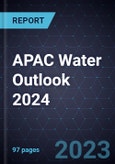Circular Economy-based Policies Driving Growth in New Water and Wastewater Infrastructure Investments
By 2050, about 1 billion people will reside in urban centers in APAC. Despite relatively high water availability, most APAC countries face water stress primarily due to uneven distribution of water. Most medium-high income economies have implemented policies favoring the reuse of treated wastewater primarily to meet growing industrial demand.
Non-revenue water (NRW) reduction, a top priority, has led to the implementation of smart water grid projects and the mass rollout of smart water meters. Investments in improving water and sanitation coverage in rural areas; capacity expansion or new production capacity development in various industries; and the adoption of ZLD.MLD systems will spur the demand for industrial water and wastewater treatment systems or expansion of existing capacity.
RESEARCH SCOPE:
The analytics highlights key market predictions for 2024, with 2023 as the base year. The municipal and industrial water market covers CAPEX (design and engineering, water and wastewater technology, process control management) and OPEX ( operation and maintenance and chemicals). It presents the total municipal and industrial water market expenditure forecast for China, Japan, India, South Korea, Australia, Indonesia, Taiwan, Thailand, Vietnam, Philippines, Malaysia, Singapore, and Rest of APAC.
KEY ISSUES ADDRESSED:
-
What are the key market predictions for the APAC water industry in 2024?
-
What is the revenue of the APAC water industry in 2024?
-
What are the regional trends/predictions and region-wise expenditure forecast for municipal and industrial segments?
-
What are the key growth opportunities and strategic imperatives of the water industry?








